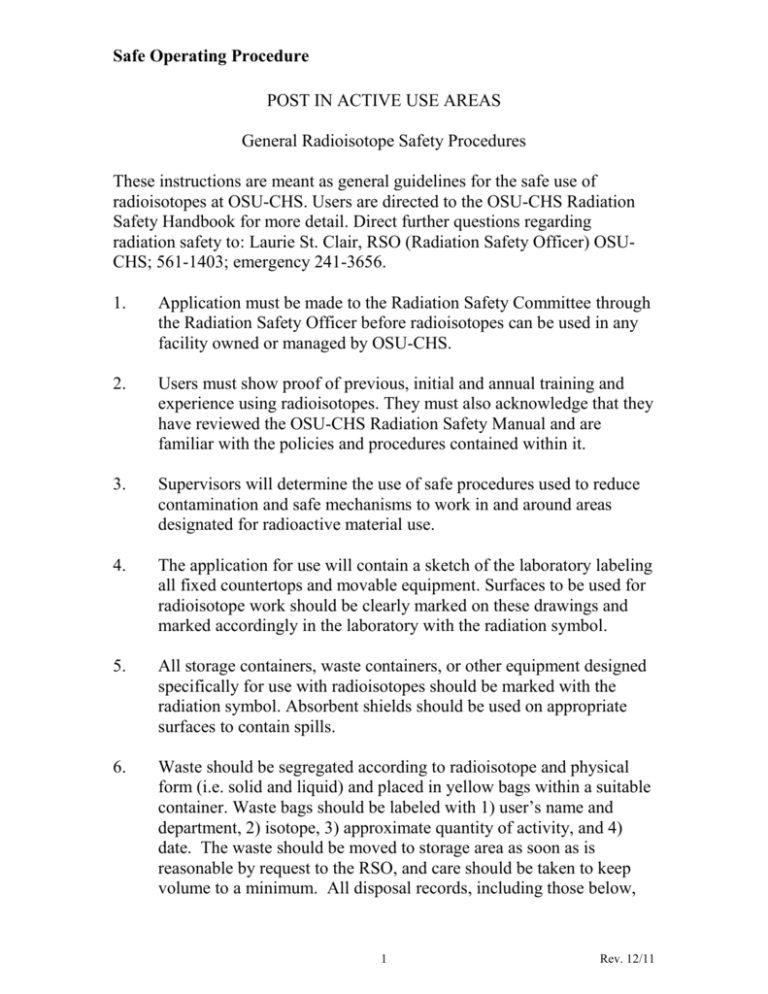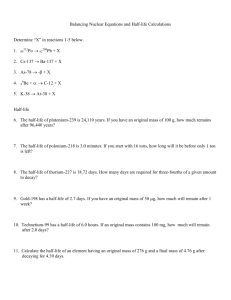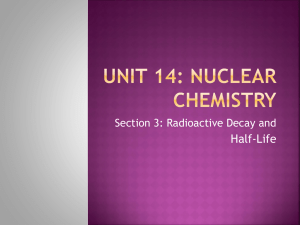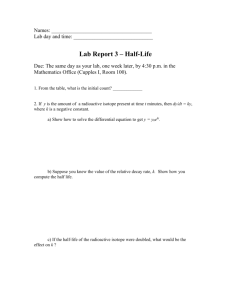General Radioisotope Safety Procedures
advertisement

Safe Operating Procedure POST IN ACTIVE USE AREAS General Radioisotope Safety Procedures These instructions are meant as general guidelines for the safe use of radioisotopes at OSU-CHS. Users are directed to the OSU-CHS Radiation Safety Handbook for more detail. Direct further questions regarding radiation safety to: Laurie St. Clair, RSO (Radiation Safety Officer) OSUCHS; 561-1403; emergency 241-3656. 1. Application must be made to the Radiation Safety Committee through the Radiation Safety Officer before radioisotopes can be used in any facility owned or managed by OSU-CHS. 2. Users must show proof of previous, initial and annual training and experience using radioisotopes. They must also acknowledge that they have reviewed the OSU-CHS Radiation Safety Manual and are familiar with the policies and procedures contained within it. 3. Supervisors will determine the use of safe procedures used to reduce contamination and safe mechanisms to work in and around areas designated for radioactive material use. 4. The application for use will contain a sketch of the laboratory labeling all fixed countertops and movable equipment. Surfaces to be used for radioisotope work should be clearly marked on these drawings and marked accordingly in the laboratory with the radiation symbol. 5. All storage containers, waste containers, or other equipment designed specifically for use with radioisotopes should be marked with the radiation symbol. Absorbent shields should be used on appropriate surfaces to contain spills. 6. Waste should be segregated according to radioisotope and physical form (i.e. solid and liquid) and placed in yellow bags within a suitable container. Waste bags should be labeled with 1) user’s name and department, 2) isotope, 3) approximate quantity of activity, and 4) date. The waste should be moved to storage area as soon as is reasonable by request to the RSO, and care should be taken to keep volume to a minimum. All disposal records, including those below, 1 Rev. 12/11 Safe Operating Procedure must be maintained and copies sent to the RSO when disposal occurs or at least quarterly. If any waste is to be placed down the college sewage system, it should only be done so after; 1) dilution to the concentration, at a minimum, listed in attached Fact Sheets item j., 2) discharged in sinks designated by the RSO for this purpose, and 3) dilution calculations maintained with disposal records in log. Isotopes with less than a 120 day half-life can be held in appropriate containers for at least 10 half-lives and disposed as ordinary trash or sink release if; 1) survey at container surface is not above background, 2) all radioactive labels are removed or defaced, and 3) a record is maintained for 3 years containing date the material was sealed and placed in storage, date of disposal, radionuclide disposed, type of waste (used or unused material; gloves, etc.), the survey instrument used, the background dose rate, dose rate measured at the surface of each waste container, where disposed (trash or sink) and name of individual who performed the survey and disposal. 7. The PI is charged with the responsibility to: a. maintain accurate records of project authorization status, laboratory inventories, surveys and disposals. b. ensure that personnel use appropriate safety equipment, (i.e. gloves, lab coats, shielding, etc) and procedures. c. acquire personnel monitoring devices and area monitoring devices from the RSO appropriate for use with a given isotope. d. ensure that the “on the job” portion of initial and annual refresher training is completed. 8. PIs shall establish daily to monthly procedures to assure timely monitoring of ongoing use and storage areas, dependent on energy of isotope and quantity in use. 9. Use of radioisotopes in animals will require special approval of the RSO contingent on amendment of the institutional license. 2 Rev. 12/11 Safe Operating Procedure RADIOISOTOPE FACT SHEETS 3 Rev. 12/11 Safe Operating Procedure RADIATION SAFETY FACT SHEET NO. 1 Properties of Tritium (H-3) (IAEA toxicity classification – low) (NBS toxicity classification – low) a) physical half-life - 12.3 years b) mode of decay – beta (-) emission (no gammas) c) maximum beta energy – 18.6 kev d) mean beta energy – 5.7 kev e) biological half-life – 12 days (tritiated water or similar compounds in total body) f) effective half-life – 12 days (tritiated water or similar compounds in total body) g) critical organ – total body h) annual limit on intake (ALI) for occupational exposure Ingestion – 8E+4 μCi Inhalation – 8E+4 μCi i) derived air concentration (DAC) for occupational exposure (ALI / ml air breathed per working year) – 2E-5 μCi/ml j) maximum allowable effluent concentrations for non-occupational exposure – Air – 1E-7 μCi/ml Water – 1E-3 μCi/ml Release to Sewers (monthly average) – 1E-2 μCi/ml k) maximum range of H-3 betas in air – 0.6 cm plexiglas – 6E-4 cm water – 7.7E-4 cm glass – 3E-4 cm tissue – 7E-4 cm (0.007 cm of skin is dead) l) fraction of H-3 betas which penetrate the dead layer of the skin at contact – none m) bremsstrahlung (X-ray) dose rate at 1 cm for 1 mCi of H-3 in a glass vial – INSIGNIFICANT 4 Rev. 12/11 Safe Operating Procedure RADIATION SAFETY FACT SHEET NO. 2 Properties of Carbon – 14 (C-14) (IAEA toxicity classification – medium – low) (NBS toxicity classification – low) a) physical half-life – 5730 years b) mode of decay – beta (-) emission (no gammas) c) maximum beta energy – 0.156 MeV d) mean beta energy – 0.049 MeV e) biological half-life – 10 days (soluble compounds in total body) f) effective half-life – 10 days (soluble compounds in total body) g) critical organ – total body/testes h) annual limit on intake (ALI) for occupational exposure Ingestion – 2E+3 μCi Inhalation – 2E+3 μCi 2E+5 μCi (C02) i) derived air concentration (DAC) for occupational exposure (ALI / ml air breathed per working year) – 1E-6 µCi/ml 9E-5 µCi/ml (CO2) j) maximum allowable effluent concentrations for non-occupational exposureAir – 3E-9 µCi/ml Water – 3E-5 µCi/ml 3E-7 µCi/ml (CO2) Release to Sewers (monthly average) – 3E-4 μCi/ml k) maximum range of C-14 betas in air – 24 cm (0.8 ft) plexiglass – 0.024 cm water – 0.03 cm glass – 0.012 cm tissue – 0.027 cm (0.007 cm of skin is dead) fraction of C-14 betas which penetrate the dead layer of the skin at contact – 0.11 l) m) bremsstrahlung (X-ray) dose rate at 1 cm for 1 mCi of C-14 in a glass vial – 0.2 mrem/hr 5 Rev. 12/11 Safe Operating Procedure RADIATION SAFETY FACT SHEET NO. 3 Properties of Phosphorus – 32 (P-32) (IAEA toxicity classification – medium-low) (NBS toxicity classification – medium) a) physical half-life – 14.3 days b) mode of decay – beta (-) emission (no gammas) c) maximum beta energy – 1.71 MeV d) mean beta energy – 0.69 MeV e) biological half-life – 257 days (soluble compounds in total body) and 1155 days in bone f) effective half-life – 13.5 days (soluble compounds in total body) and 14.1 days in bone g) critical organ – bone/total body h) annual limit on intake (ALI) for occupational exposure – Ingestion – 6E+2 µCi Inhalation – 4E+2 µCi i) derived air concentration (DAC) for occupational exposure (ALI) / ml air breathed per working year) – 2E-7 µCi/ml j) maximum allowable effluent concentrations for non-occupational exposureAir – 5E-10 µCi/ml Water – 9E-6 µCi/ml Release to Sewers (monthly average) – 9E-5 μCi/ml k) maximum range of P-32 betas in air- 720 cm (23.6 ft) plexiglass – 0.72 cm water – 0.92 cm glass – 0.35 cm tissue – 0.84 cm (0.007 cm of skin is dead) l) fraction of P-32 betas which penetrate the dead layer of the skin at contact – 0.95 m) bremsstrahlung (X-ray) dose rate at 1 cm for 1 mCi of P-32 in a glass vial – 32.8 mrem/hr 6 Rev. 12/11 Safe Operating Procedure RADIATION SAFETY FACT SHEET NO. 4 Properties of Iodine – 125 (I-125) (IAEA toxicity classification – medium – high) (NBS toxicity classification – none) a) physical half-life – 60 days b) mode of decay – electron capture (no particle or gamma emission) Radiation type is x-rays from orbital shell (97%) and internal conversion electrons (93%) c) X-ray energy – Te – X-Ray – 35 keV (7%) d) mean energy – N/A e) biological half-life – 138 days (soluble compounds in total body and thyroid) f) effective half-life – 41.8 days (soluble compounds in total body and thyroid) g) critical organ - thyroid h) annual limit on intake (ALI) for occupational exposure Ingestion – 4E+1 µCi Inhalation – 6E+1 µCi i) derived air concentration (DAC) for occupational exposure (ALI / ml air breathed per working year) – 3E-8 µCi/ml j) maximum allowable effluent concentrations for non-occupational exposureAir – 3E-10 µCi/ml Water – 2E-6 µCi/ml Release to Sewers (monthly average) – 2E-5 μCi/ml k) specific dose rate constant – 0.7 R/hr per mCi at 1 cm l) dose rate at a distance of 1m for 1 mCi of I-125 – 0.07 mR/hr m) lead shielding required to reduce the dose rate by a factor of 10 – 7.0 mm 7 Rev. 12/11 Safe Operating Procedure RADIATION SAFETY FACT SHEET NO. 5 Properties of Sulfur – 35 (S-35) (IAEA toxicity classification – medium – low) (NBS toxicity classification – medium) a) physical half-life – 87.4 days b) mode of decay – beta (-) emission (no gammas) c) maximum beta energy – 0.167 MeV d) mean beta energy – 0.049 MeV e) biological half-life – 90 days (soluble compounds in total body) f) effective half-life- 44.3 days (soluble compounds in total body) g) critical organ – total body/testes h) annual limit on intake (ALI) for occupational exposureIngestion – 6E+3 µCi Inhalation – 2E+3 µCi 1E+4 µCi (vapor) i) derived air concentration (DAC) for occupational exposure (ALI / ml air breathed per working year) – 9E-7 µCi/ml 6E-6 µCi/ml (vapor) j) maximum allowable effluent concentrations for non-occupational exposureAir – 3E-9 µCi/ml Water – 1E-4 µCi/ml 2E-8 µCi/ml (vapor) Release to Sewers (monthly average) – 1E-3 μCi/ml k) maximum range of S-35 betas in air – 30 cm (0.98 ft) plexiglass- 0.03 cm water – 0.039 cm glass – 0.015 cm tissue – 0.035 cm (0.007 cm of skin is dead) l) fraction of S-35 betas which penetrate the dead layer of the skin at contact – 0.16 m) bremsstrahlung (X-ray) dose rate at 1 cm. for 1 mCi of H-3 in a glass vial – 0.3 mrem/hr 8 Rev. 12/11 Safe Operating Procedure RADIATION SAFETY FACT SHEET NO. 6 Properties of Chromium – 51 (Cr-51) (IAEA toxicity classification – medium – low) (NBS toxicity classification – medium) a) physical half-life – 27.7 days b) mode of decay – electron capture (no particle or gamma emission) Radiation type is X-rays from orbital shell (9%) and internal conversion electrons (91%) c) X-ray energy – 320 keV (9%), 5 keV (22%) d) mean energy – N/A e) biological half-life – 616 days (soluble compounds in total body) f) effective half-life – 26.6 days (soluble compounds in total body) g) critical organ – lower large intestine (LLI) /total body h) annual limit on intake (ALI) for occupational exposure Ingestion – 4E+4 µCi Inhalation - 2E+4 µCi i) derived air concentration (DAC) for occupational exposure (ALI / ml air breathed per working year) – 1E-5 µCi/ml j) maximum allowable effluent concentrations for non-occupational exposure Air – 3E-8 µCi/ml Water – 5E-4 µCi/ml Release to Sewers (monthly average) – 5E-3 μCi/ml k) specific dose rate constant – 0.159 R/hr per mCi at 1cm l) dose rate at a distance of 1m for 1 mCi of Cr-51 - 1.59E-2 mR/hr m) lead shielding required to reduce the dose rate by a factor of 10 – 7.0 mm 9 Rev. 12/11









